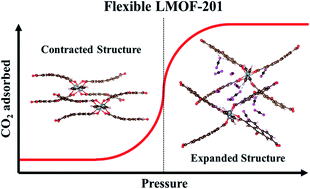Molecular simulation study on the flexibility in the interpenetrated metal–organic framework LMOF-201 using reactive force field†
Abstract
Framework flexibility is one of the most important characteristics of metal–organic frameworks (MOFs), making them highly suitable for adsorption applications. There have been a limited number of computational efforts to study flexible MOFs in the literature, and they are mostly focused on MIL-53. We studied a flexible MOF known as LMOF-201, which was found to exhibit guest-induced flexible properties; however, the mechanism of the appearance of flexibility is still unclear. First, we validated our simulation results by reproducing the experimental isotherm and powder X-ray diffraction measurements of experimental structures using grand canonical Monte Carlo (GCMC) and reactive force field (ReaxFF) molecular dynamics (MD) simulations. Then, we demonstrated the importance of the presence of a carbonyl oxygen atom in LMOF-201 to induce flexibility. The mechanism determined in this study will enable LMOF-201 to be considered for adsorption applications in the future.



 Please wait while we load your content...
Please wait while we load your content...